WESTERN PROVINCE RUGBY
Authoritative study finds no grounds for declaring Newlands Stadium a heritage site
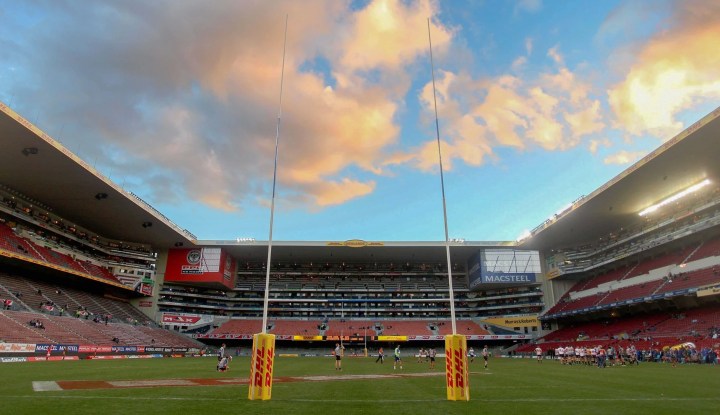
A little more than 24 hours before the Stormers take on the Bulls at Loftus Versfeld in a crunch United Rugby Championship match, the Western Province Rugby Football Union (WPRFU) should take a step closer to stability.
On Friday, 17 February, the Western Province Rugby Football Union (WPRFU) will be a step closer to knowing whether it will be allowed to proceed with the sale of Newlands Stadium’s development rights.
They are crucial to the union’s survival and its ability to pay off debts of more than R200-million after several years of malfeasance by the union’s leaders led to it being placed under administration in 2021.
Heritage Western Cape, the body tasked with determining whether structures and buildings are allowed to be altered or demolished, meets on Friday to discuss feedback from the public participation process over the future of Newlands. The public participation process deadline was on 31 January.
In short, an attempt to have Newlands declared a heritage site following an objection by former Springbok captain Wynand Claassen, and therefore ineligible for demolition, doesn’t have any legitimate claim. At least, according to an authoritative study.
No grounds
A 93-page report compiled by Bridget O’Donoghue, an architect and heritage specialist, presented to the Heritage Western Cape, Inventories, Grading and Interpretation Committee, found no grounds that Newlands meets the criteria for a heritage site.
“Based on the information available at the time of preparing the Social Statement, none of the structures associated with the Newlands Stadium [is] of heritage significance,” the report reads.
“Based on the findings of the study, the demolition of the Newlands Stadium, like the demolition of many other historically significant stadiums in other parts of the world, would not represent an irreplaceable social loss.
“While Newlands does hold special memories for many rugby supporters, for the current generation the future of rugby is already associated with the Cape Town Stadium.
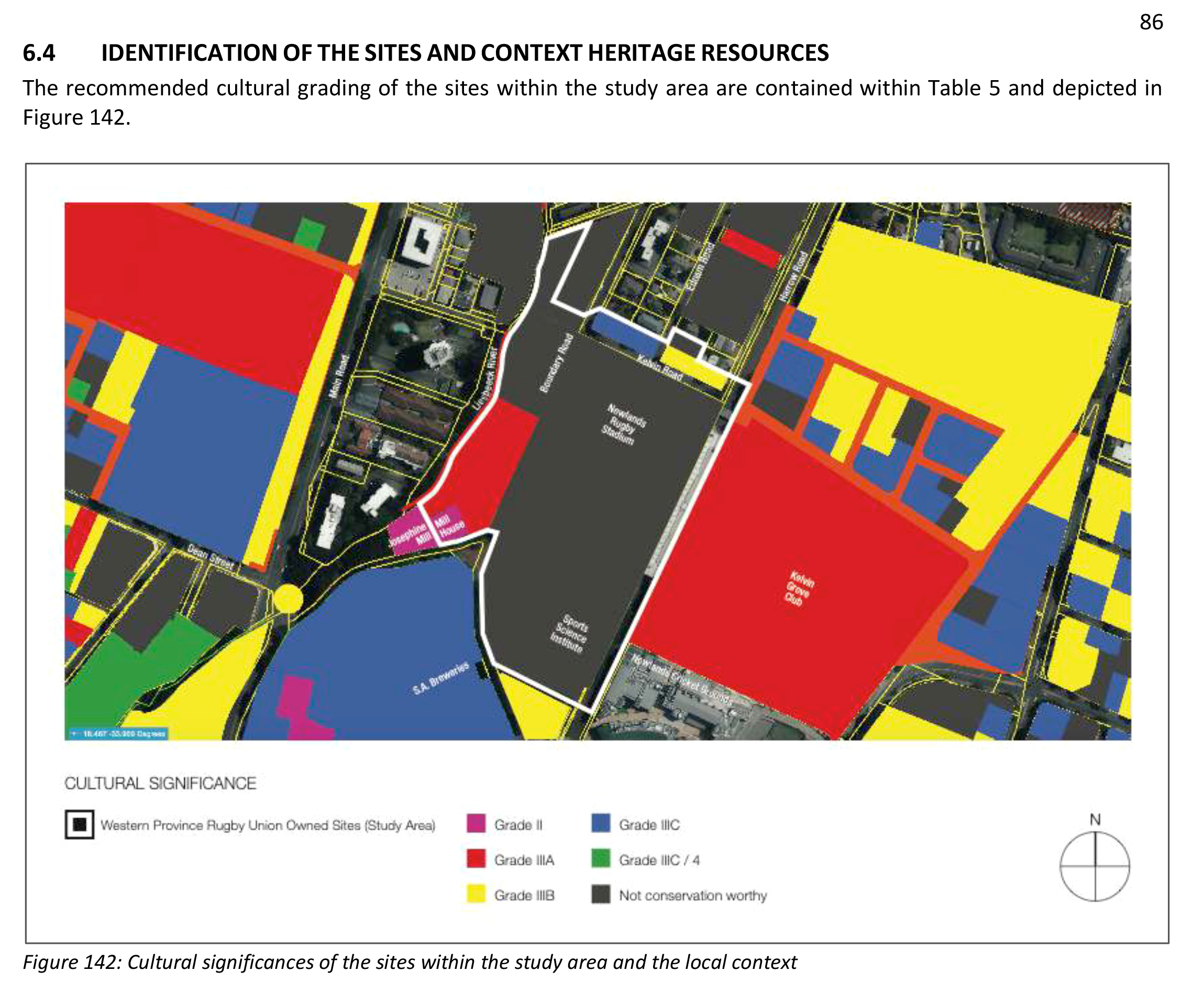
Cultural grading of the Newlands site clearly shows that Newlands Stadium is not eligible for Heritage Status. (Image from the Heritage report Page 86.)
“A number of interviewees indicated the survival of the game, and the Western Province Rugby Football Union should take precedence in any decisions regarding the future of Newlands Stadium.
“This reflects the situation faced by other sports clubs and unions that have taken the decision to relocate and use the sale of their old premises to fund the move and/or the construction of a new facility.”
Visit Daily Maverick’s home page for more news, analysis and investigations
Heritage claims fail test despite wide scope
The National Heritage and Resources Act (NHRA) has broad guidelines for structures to fall into the heritage orbit, which is not only limited to the actual physical structure.
According to the act: “A heritage resource is described as ‘any place or object of cultural significance’ (NHRA Section 26 [xvi]). Heritage resources significant enough to be considered part of the national ‘estate’ in Section 3(2) of the NHRA may include, inter alia:
- Places, buildings, structures and equipment of cultural significance;
- Places to which oral traditions are attached or which are associated with living heritage;
- Historical settlements and townscapes;
- Landscapes and natural features of cultural significance;
- Geological sites of scientific or cultural importance;
- Archaeological sites and objects;
- Graves and burial grounds;
- Sites of significance relating to the history of slavery in South Africa; and
- Moveable objects including military objects, fine art, books, records, documents, archaeological and paleontological objects, and materials.”
Claassen’s claim focused specifically on the first point, of Newlands being a place of “cultural significance”. But that was a stretch because it raises the issue of “whose culture?”
“The majority of clubs that we have canvassed oppose the heritage application for many reasons, which are outlined in our letter to the Western Cape Government,” the president of Tygerberg Rugby Club, Kevin Kiewitz, told Daily Maverick.
In a letter from Tygerberg Rugby Club to the City of Cape Town, opposing Claassen’s heritage claim, Kiewitz wrote:
“Newlands Stadium, prior to 1994 represented a divided history which for almost the first 100 years of its existence was exclusively reserved for 7% of this country’s population.
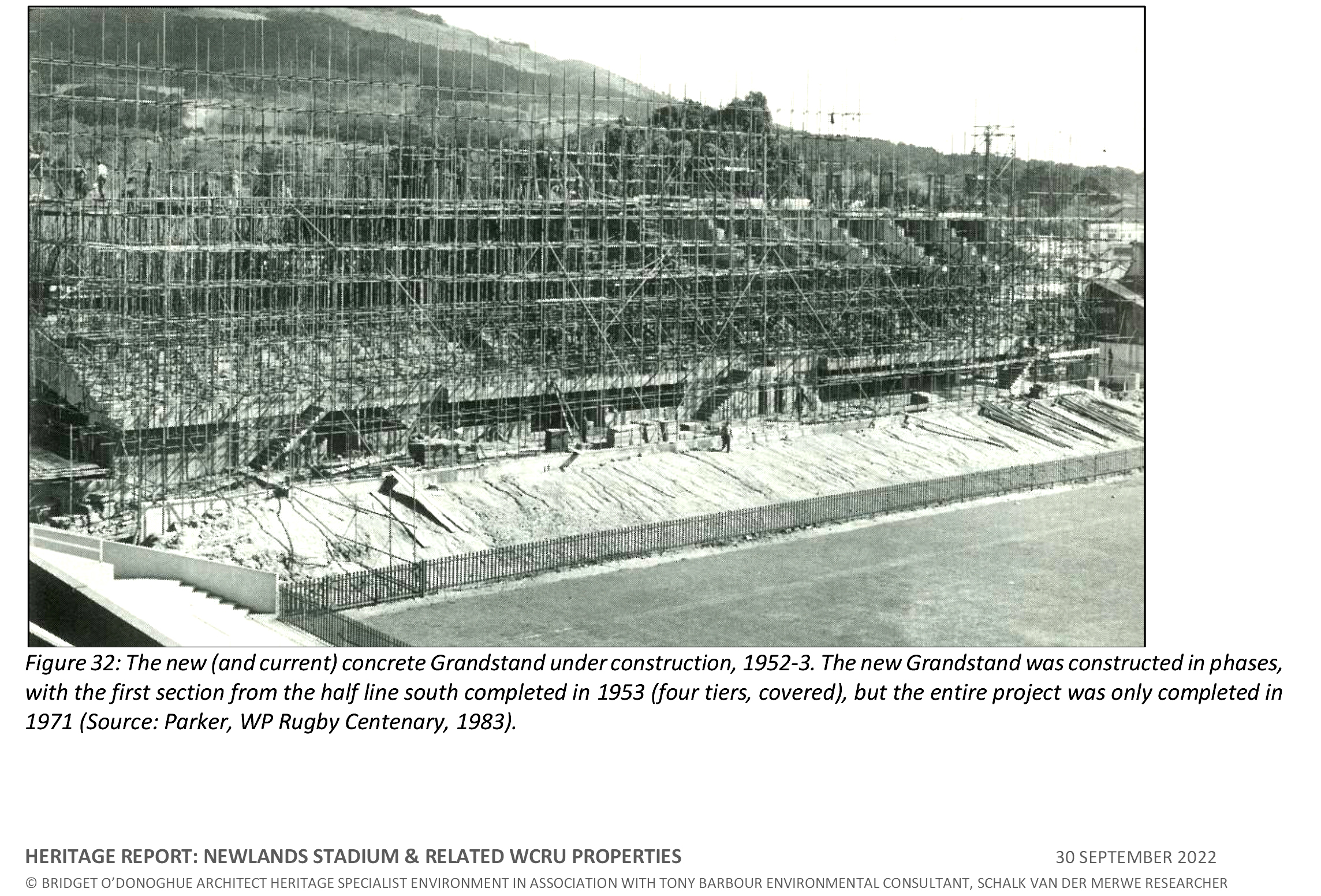
Newlands undergoing one of its many redevelopments in the early 1950s. (Heritage report page 20.)
“Despite the historical significance of the 1995 World Cup games, the overwhelming significance is one of oppression and exclusion.
“The stadium’s history and significance can easily be included in a museum. However, I must caution though, even that is debatable, because when SA Rugby managed a rugby museum in the Waterfront it was not commercially viable.
“The only place it could potentially work is if we allocate space for a museum at the new home of Western Province Rugby, being Cape Town Stadium.
“The commercial viability of the Newlands Stadium has long lost its usefulness because of the modern-day requirements for [the] public and the statutory requirements, which deal with access and the need to comply with the safety of large groups of spectators who attend rugby games.
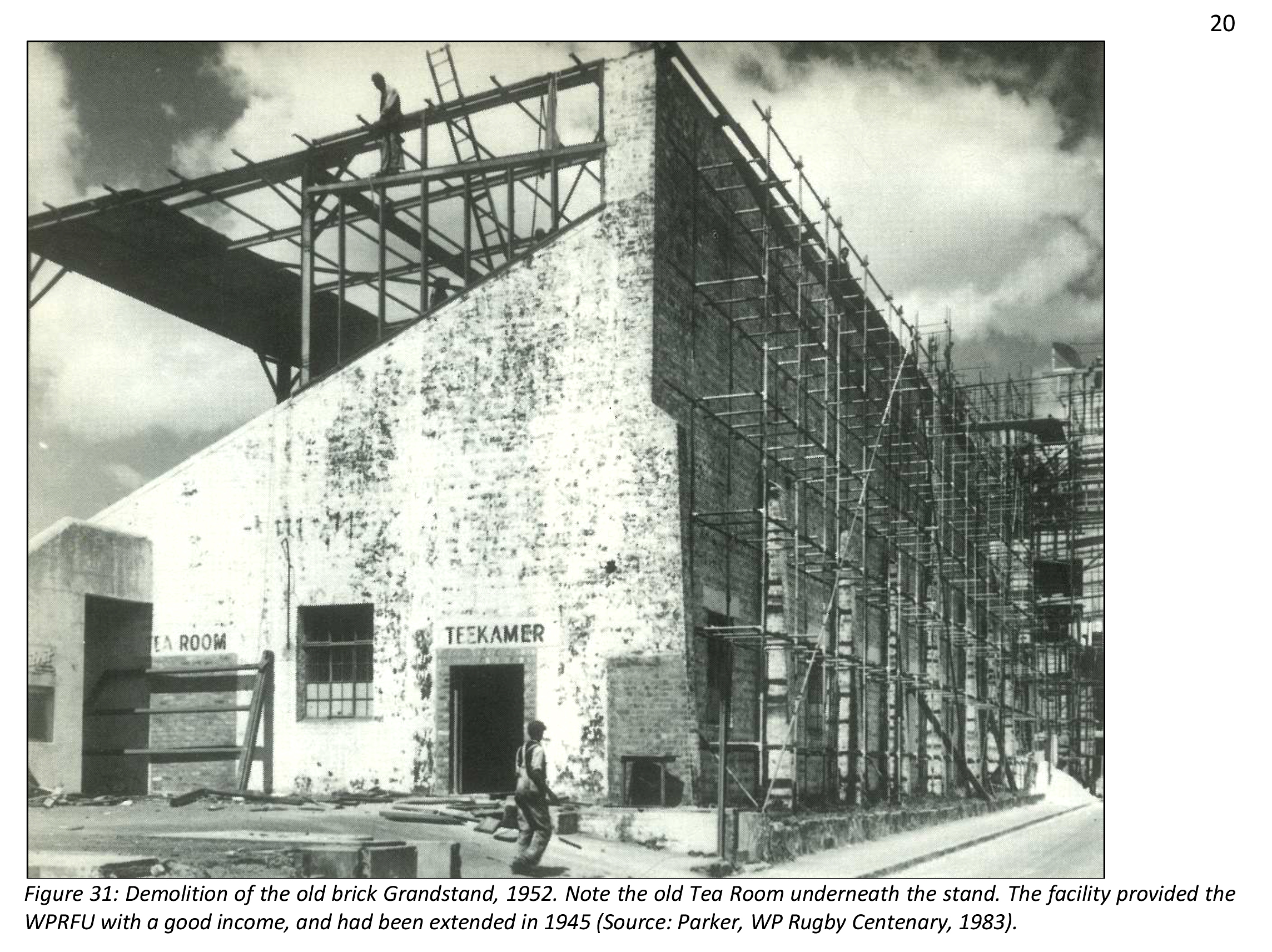
Image of Newlands circa 1952 taken from the Heritage report page 20.
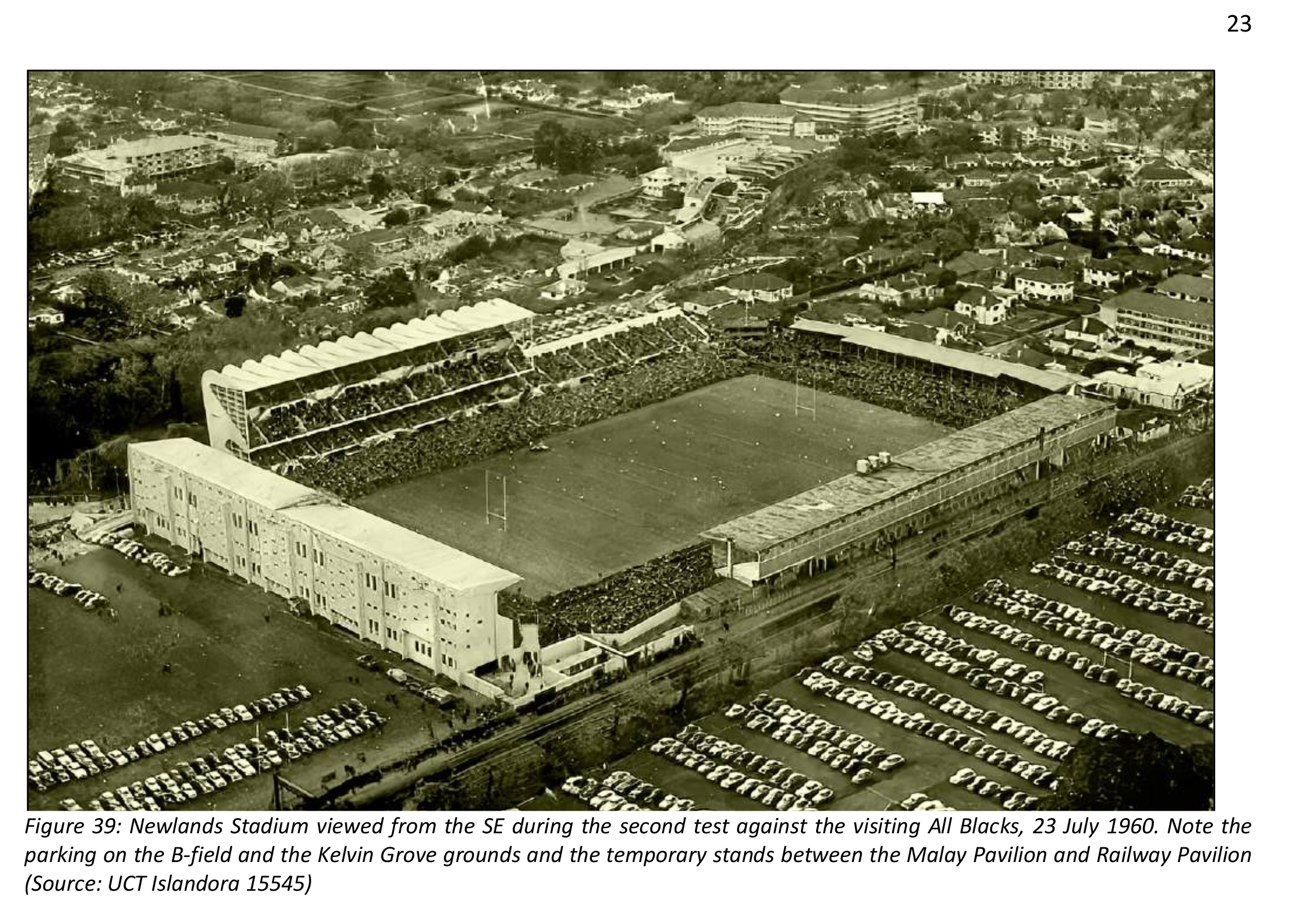
Image of Newlands circa 1960 taken from the Heritage report page 23.
“Nowhere in the world have rugby stadiums been declared heritage sites, because it is simply not practical and the economic imperatives far outweigh any perceived heritage value.
“Currently, the delays caused by this application have further resulted in unsustainable financial losses to WP Rugby because we urgently need to commercialise the property to settle our [WP Rugby’s] ever-increasing debt.”
Police Rugby Club issued a letter with similar sentiments, which is in Daily Maverick’s possession, and the WPRFU manager of amateur rugby, Danny Jones, recently stated: “All of the WPRFU’s proper processes were followed when it was decided that our professional teams would play their rugby at Cape Town Stadium.
“Newlands Stadium cannot currently be used to host rugby matches, but its sale remains crucial to the future of the WPRFU and we are hopeful that all stakeholders will do their utmost to ensure that happens.”
Continual Newlands redevelopment
The study by the Heritage Committee went into great detail about the structural metamorphosis of the stadium over more than a century. It concluded that the oldest structure in the stadium itself was built in 1953. Most of the others were redeveloped in the 1970s and 1980s.
“The Newlands Rugby Stadium ground was used for playing rugby from 1890. The first stand was a small wood and iron pavilion along Kelvin Road,” the study states.
“A Victorian double-storey Members’/President’s Pavilion was constructed in the North-West corner in 1896, and by 1906 (and probably earlier) two larger stands had been constructed along Boundary Road and Kelvin Road, respectively, with the latter the ‘main’ stand.
“The ‘main’ stand burnt down in 1919 and was replaced by the first concrete pavilion around 1920. The field was re-orientated North/South in 1927, and the ‘main’ stand switched to a new brick pavilion along Boundary Road. The first stands were also constructed to the south (‘Malay Pavilion’) and east (Railway) of the field during the late 1920s-early 1930s.

The Stormers’ Marcel Theunissen is tackled by Tom Stewart of Ulster during a United Rugby Championship match at Kingspan Stadium in Belfast on 27 January 2023. (Photo: Ramsey Cardy / Sportsfile / Gallo Images)
“The old brick Main Stand and ramshackle ‘Malay Pavilion’ were demolished around 1952, and replaced with new structures. The existing four-tiered Main Stand was completed in phases between 1953 and 1971. The old Members Pavilion, then the oldest structure on the grounds, was badly damaged in 1970, and subsequently demolished.
“The old 1920 concrete pavilion along Kelvin Road appears to have been demolished to make way for the concrete foundations of what would become the existing Jan Pickard Stand around the same time.
“The old Railway Stand was replaced by the existing structure in 1979. The ‘Malay Pavilion’ was replaced by the existing Danie Craven Stand (opened 1987).
“The Jan Pickard Stand was opened in 1989. The last major upgrades to the stadium occurred in preparation for the 1995 Rugby World Cup. By 1995, tall stands completely enclosed the playing field (‘wrap-around effect’), and the renowned views of Table Mountain from inside the stadium had essentially become restricted to the top tiers of the Railway Pavilion.
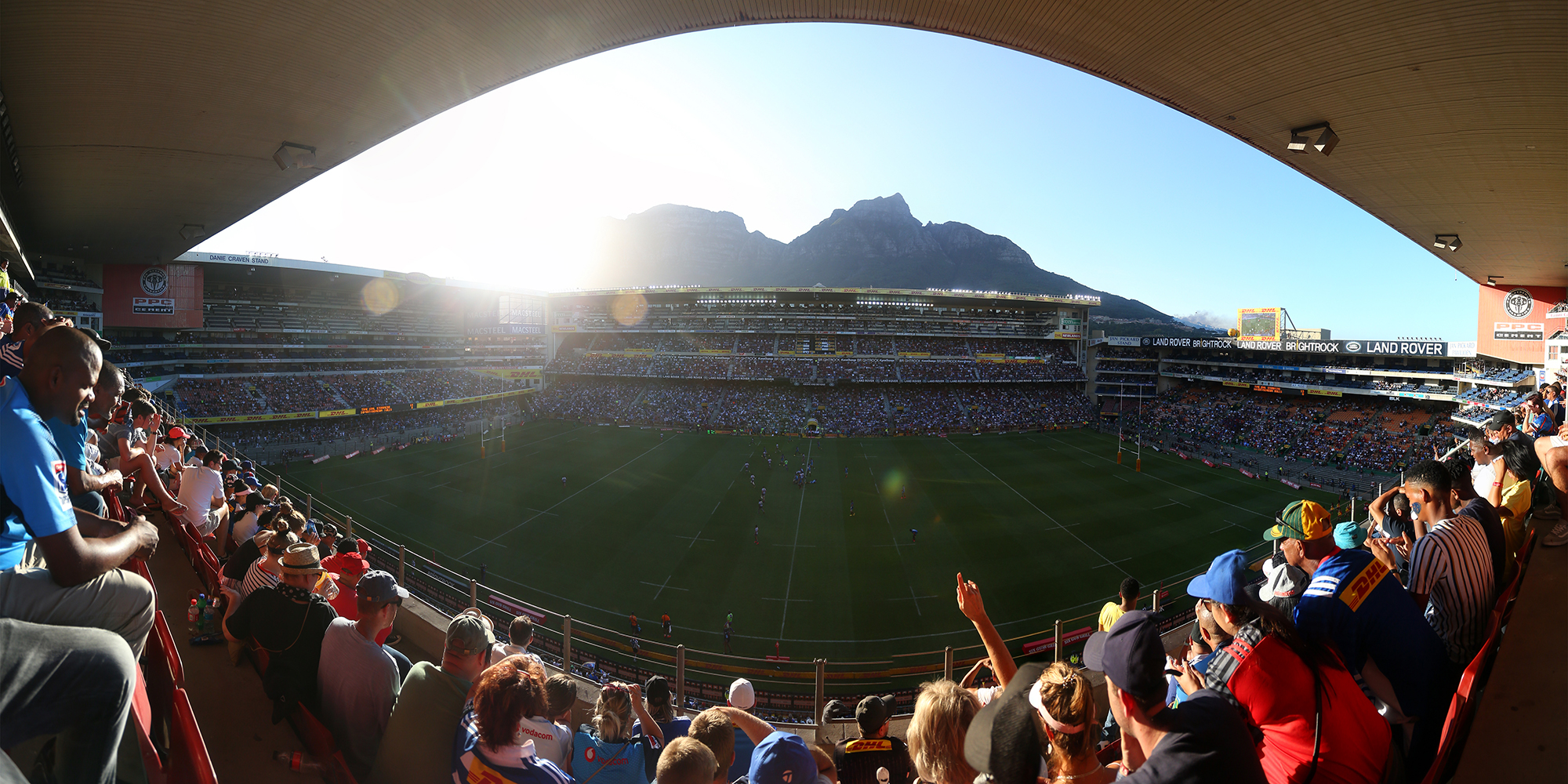
Newlands Rugby Stadium. (Photo: Western Province Rugby)
“In summary, it would appear that the oldest surviving stadium fabric dates to around 1953, namely the portion of the grandstand south of the halfway line and the foundations and first two tiers of the balance.
“Sources suggest that the existing fabric on the other three stands completely replaced their predecessors during the 1970s and 1980s. No old fabric is immediately apparent from either inside or outside the stadium.
“The potential presence of hidden older core elements can, however, not be categorically excluded without studying the plans or a physical inspection by an architect.”
Many precedents
The report goes into significant detail concerning how other rugby and sports stadiums were either demolished or redeveloped to move with modern times.
“The Carisbrook Stadium (House of Pain) in Dunedin and Athletic Park in Wellington both share similar histories to the Newlands Stadium both in terms of timeframes and contribution to rugby in their respective countries,” the report states.
“Carisbrook and Athletic Park were established in 1881 and 1896, respectively, whilst Newlands was established in 1889 and the first game of rugby was played in 1890. Likewise, both Carisbrook and Athletic Park feature prominently in the history of New Zealand (All Black) rugby, as does Newlands in terms of South African (Springbok) rugby.
“In both instances, these historic stadiums were demolished, and the home unions relocated to new, modern stadiums. The old stadium sites were redeveloped.
“From a heritage perspective, it would appear that in the majority of instances the old stadium and associated structures are demolished in their entirety. In a number of isolated cases, such as Arsenal’s Highbury stadium, the art deco East Stand, which is a listed Grade II heritage resource (Heritage England: ‘particularly important buildings of more than special interest’), was retained and included as part of the redevelopment of the old stadium site.” DM

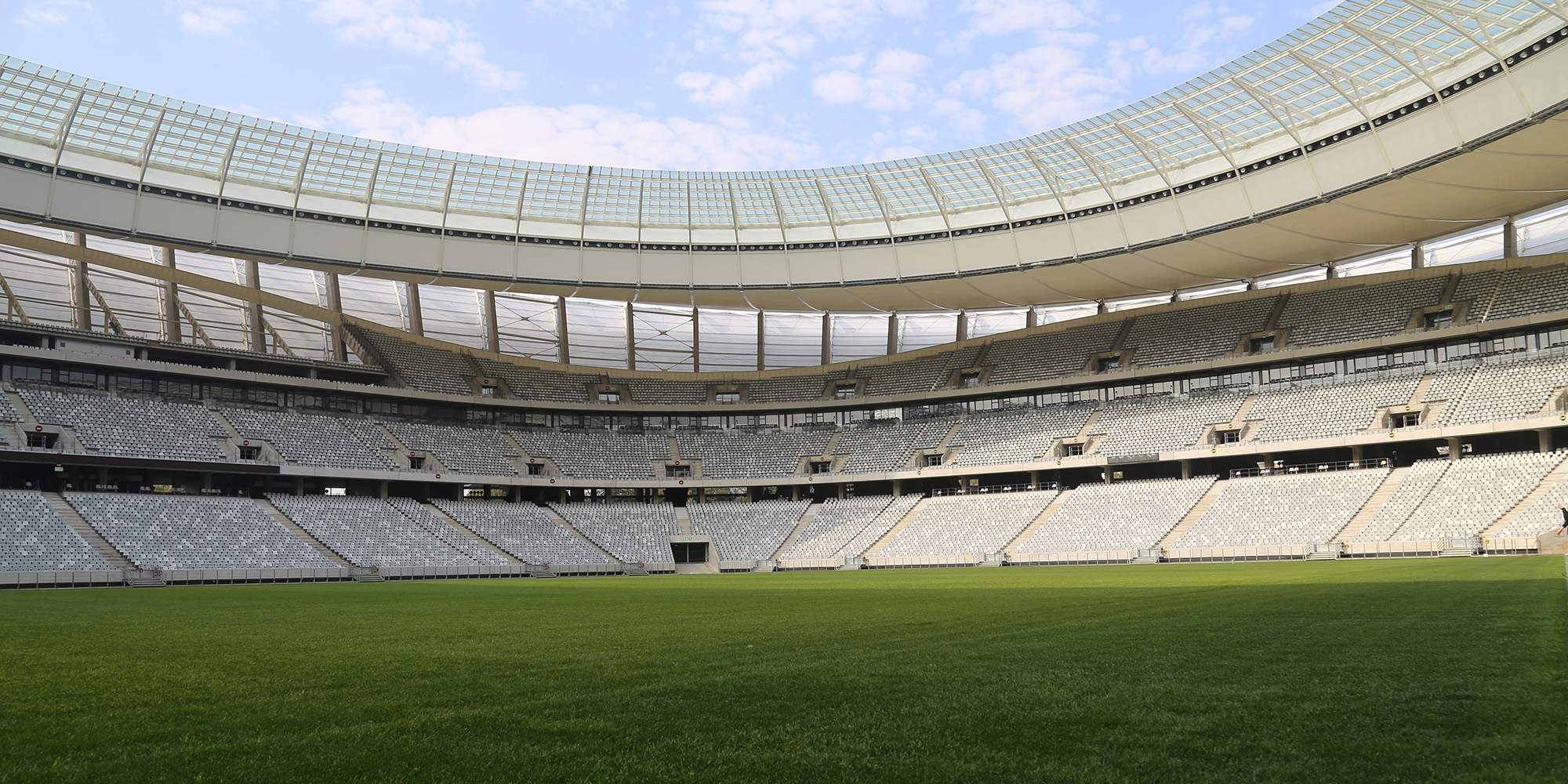

















It amazes me that in both articles (this one and the one from 23rd January) the protagonist for the ‘heritage’ case is called ‘the Springbok Wynand Claasen’ where in fact he should really be called ‘the Architect Wynand Claasen’. Makes things so much clearer about where him and his mates are coming from?